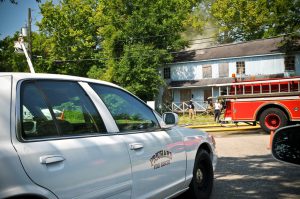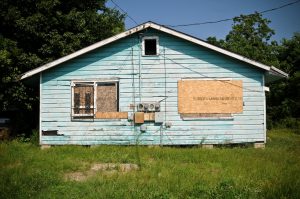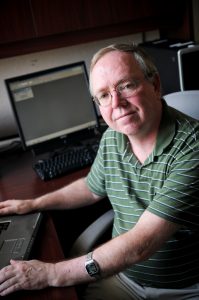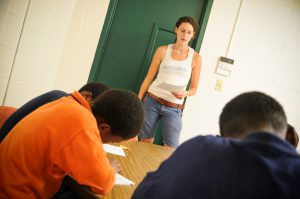By Michael Washington
Photos by Zachary Riggins

Dr. John Bolland sits at his desk in the Mobile Teen Center calmly watching as a cast of student interns busily organizes before charging out of the door to neighborhoods throughout the city. It’s time to conduct another survey.
The Mobile Youth Survey, beginning its 13thyear, is a longitudinal survey collecting data in 33 low-income neighborhoods in the Alabama port city as well as the neighboring town of Prichard.
The purpose of the survey is to study the origins of risk behaviors among adolescents living in extreme poverty; study how contextual factors such as family, school and neighborhood affect the origin of the risk behaviors; and establish a community laboratory where residents will be receptive to interventions and complementary studies.
The interns spend nine weeks of the remarkably hot summer knocking on doors in these neighborhoods, recruiting adolescents to participate in the study, scheduling them to come to a community center—schools, churches, apartments, and any other locations they are able to use—to be surveyed.
The neighborhoods range from lower-middle class areas while others are public housing areas of various level of repair. And, still others are inner-city slums with burned-out buildings, marshy lots, tall grass and trash as far as the eye can see. Children can be heard playing; yet the despair is, at times, tangible.

“Have you ever read any [William] Faulkner?” asks Bolland in response to an inquiry of the day’s events and locations. “Good,” he replies to an affirmative response, “then you’ll have the words to describe what you see. His writing about race and class distinction comes to mind when I’m describing it to visitors.”
It is the setting of this human drama that attracts Bolland, a professor and research chairholder in UA’s College of Human Environmental Sciences, and his interns from around the country. The inhabitants of these neighborhoods—the cast of characters—tell the story of how neighborhood differences may affect the development and behavior of the young people living there, and how violence and drug prevention programs operate in these areas.
“We can tell 13-year-olds in these neighborhoods to wear condoms to protect themselves from HIV, which could manifest as AIDS at the age of 25, then possibly lead to death by age 35,” says Bolland. “Do you think that approach would work with a kid that expects to be killed by gunfire at 20? There’s a shortage of hope that has to be addressed first.”

Results from the survey have already revealed that hopelessness pervades these communities. Bolland found substantial levels of hopelessness that was measured at twice that of youth from other low-income areas across the South and well within range of those who receive inpatient psychiatric care.
“Society tells us that if you are not in a certain income bracket, you must have a character flaw,” Bolland shares off-handedly. “This kind of environment is the place of last recourse. In years of coming here, I’ve seen great kindness from the people who’ve invited me into their homes.”
The local ecology of the neighborhoods such as population density and civic leadership also play a role. Trees, green space and active residents who encourage pride and safety have made a difference in some of the neighborhoods included in the study. Bolland believes that socialization is key to combating the hopelessness and lack of cooperation that keeps most neighborhoods isolated.
“The only way to address the depression that exists is to build a sense of community. Something as simple as a quilting bee or neighborhood meeting is a good start to bring people together,” he says.
“They are afraid of each other. They realize that they themselves are trapped in a series of unfortunate circumstances, but their neighbors must have done something to deserve a life of poverty. We as a society have facilitated that notion; and we all fall victim to it. They’re just on the receiving end.”
After years of social science research in Mobile, more than 7,500 adolescents interviewed and countless studies, research papers and news reports, Bolland himself has transformed his own depression into a healthy kind of anger that drives him to share the importance of social science research with his young colleagues.
If Bolland were the protagonist of this story, then the interns are his faithful sidekicks with top billing. The research internship is offered each summer for students from around the country, during which they learn about, and conduct, field research. After a week of intensive training, the interns set about the task of surveying participants. They meet one morning each week to discuss their experiences and talk about results of the study. For most of the students, the Mobile Youth Survey is the first time that they have actually been in low-income neighborhoods.

When faced with the realities of their subjects, the interns usually undergo a profound shift in how they view society, themselves and their research. Some have trouble reconciling a desire to be agents of change while being a researcher able to continue working in the face of abject poverty.
Nikki Langley, a former intern from the University of Alabama at Birmingham, recalls the highs and lows of a survey internship. She shares a heartbreaking story in which she travelled to visit a 15-year-old boy who missed his appointment because he was killed by gunfire in the interim.
But, “although we’re tired, both emotionally and physically, we all prepare for another day on the streets of Mobile where we hope to impact that one child who comes up to us, tugs at our shirt and says, ‘Are you the survey people?’ Those are the days that make it all worth it,” Langley says. “Those are the days that give me hope.”
Bolland encourages that sentiment in all the Mobile Youth Survey interns. He remarks with a slightly defiant tone, “Sometimes interns share with me that they don’t feel as though the research route is going to make a big impact as would a community service project. They go hand-in-hand. If I can encourage the interns to see that social science research is a worthwhile pursuit that can give a face to the numbers that represent these people on paper, then I’ve done my job.”
Driving among the lovely, Victorian-styled homes of Dauphin Street, it’s striking—even jarring to the senses—that just blocks away there are communities filled with abandoned, burned out buildings and alienated people who expect to see nothing other than what they’ve always seen. Bolland and the interns were right in their personal accounts that continued exposure is damaging to the psyche.
For the inhabitants, despair prevails. For those who study it, anger emerges. Nonetheless, the research continues, and the interns continue signing-up. For now, the hopelessness remains tangible in the place of last recourse.
Contact
Sarah Colwell, College of Arts and Sciences, 205/348-8539, sccolwell@as.ua.eduRebecca Florence, 205/348-8663